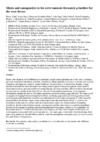Identificador persistente para citar o vincular este elemento:
https://accedacris.ulpgc.es/jspui/handle/10553/107231
| Título: | Micro and nanoplastics in the environment: Research priorities for the near future | Autores/as: | Vighi, Marco Bayo, Javier Fernández-Piñas, Francisca Gago, Jesús Gómez, May Hernández-Borges, Javier Herrera, Alicia Landaburu, Junkal Muniategui-Lorenzo, Soledad Muñoz, Antonio-Román Rico, Andreu Romera-Castillo, Cristina Viñas, Lucía Rosal, Roberto |
Clasificación UNESCO: | 3308 Ingeniería y tecnología del medio ambiente | Palabras clave: | Microplastics Nanoplastics Standardization Internalization Environmental risk, et al. |
Fecha de publicación: | 2021 | Editor/a: | Springer | Proyectos: | EnviroPlaNet RED2018-102345-T | Resumen: | Plastic litter dispersed in the different environmental compartments represents one of the most concerning problems associated with human activities. Specifically, plastic particles in the micro and nano size scale are ubiquitous and represent a threat to human health and the environment. In the last few decades, a huge amount of research has been devoted to evaluating several aspects of micro/nanoplastic contamination: origin and emissions, presence in different compartments, environmental fate, effects on human health and the environment, transfer in the food web and the role of associated chemicals and microorganisms. Nevertheless, despite the bulk of information produced, several knowledge gaps still exist. The objective of this paper is to highlight the most important of these knowledge gaps and to provide suggestions for the main research needs required to describe and understand the most controversial points to better orient the research efforts for the near future. Some of the major issues that need further efforts to improve our knowledge on the exposure, effects and risk of micro/nano-plastics are: harmonization of sampling procedures; development of more accurate, less expensive and less time consuming analytical methods; assessment of degradation patterns and environmental fate of fragments; evaluating the capabilities for bioaccumulation and transfer to the food web; and evaluating the fate and the impact of chemicals and microorganisms associated with micro/nano-plastics. The major gaps in all sectors of our knowledge, from exposure to potentially harmful effects, refer to small size microplastics and, particularly, to the occurrence, fate, and effects of nanoplastics. | URI: | https://accedacris.ulpgc.es/handle/10553/107231 | ISBN: | 978-3-030-88217-4 | DOI: | 10.5281/zenodo.4767185 | Fuente: | Reviews of Environmental Contamination and Toxicology / de Voogt, Pim (ed.), v. 257, p. 163–218 |
| Colección: | Capítulo de libro |
Visitas
428
actualizado el 02-mar-2024
Descargas
302
actualizado el 02-mar-2024
Google ScholarTM
Verifica
Altmetric
Comparte
Exporta metadatos
Los elementos en ULPGC accedaCRIS están protegidos por derechos de autor con todos los derechos reservados, a menos que se indique lo contrario.
